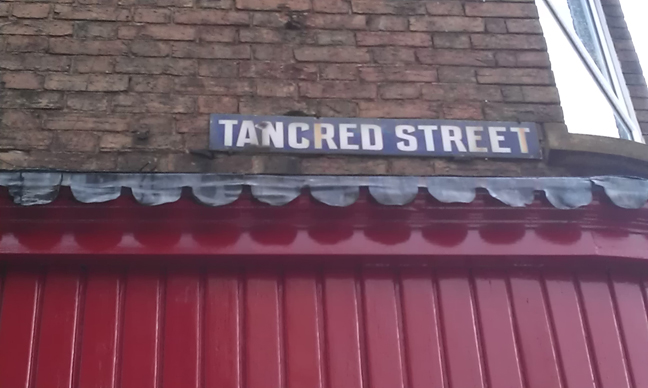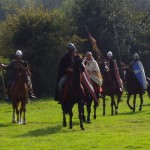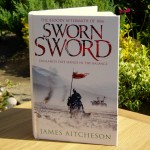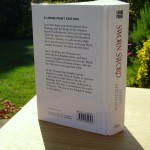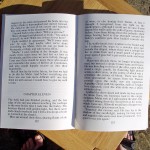I was recently sent the above photo by fellow historical novelist Ben Kane, author of the bestselling Hannibal: Enemy of Rome, who happened upon Tancred Street while visiting Taunton last month.
Since my Tancred is a fictional character and not based on any particular historical figure, unfortunately I can’t claim that it was named after him. Still, it started me wondering whether there might be any other streets or places (either in Britain or abroad) that share the names of characters from Sworn Sword.
Is there a Wace Crescent, for example, or a Malet Street? Somewhere in the world does there exist a Eudo Drive, a Radulf Walk, an Aubert Avenue, or even an Ælfwold Terrace?
Let me know if you come across any good examples, either by getting in touch with me via the Contact page or by posting pictures on Twitter, using the #SwornSword hashtag and/or tweeting me at @JamesAitcheson. I’ll post the best photos here on the website for all to see.
This week I returned to the place where Tancred’s story begins – to Durham, where the city’s annual Book Festival has been taking place this month. An enthusiastic audience joined myself and my event host, Dr Giles Gasper, lecturer in medieval history at Durham University, for a discussion about Sworn Sword and its connection with the city.
One of the questions I was asked was why I chose Durham in particular as the place to begin the novel. In fact the battle that forms the opening chapters was a real-life event that took place on or around 28 January 1069, and it’s spoiling none of the plot to say that it marked a significant turning-point in the story of the Conquest. Indeed this was the biggest defeat that the Normans had suffered since arriving on these shores more than two years previously.
Around Christmas 1068, William the Conqueror appointed Robert de Commines, Tancred’s lord, as Earl of Northumbria, the only part of England that had thus far refused to acknowledge him as king. Together with his army – the sources disagree on exactly how many men – Robert marched to subdue the recalcitrant northerners and take the province by force. Soon after arriving in Durham, however, the earl and his forces were routed in a surprise attack under the cover of darkness. The Normans were cut down in the streets and Robert himself was killed. There were few survivors.

View of the tower and north transept of Durham Cathedral.
Walking around the city on my visit there this week, I was reminded just how dramatic a location Durham is, and how its very geography makes it a fascinating setting for a battle. The castle and the cathedral that nowadays dominate the skyline had not yet been built by 1069, but the peninsula on which they are built would have made this a naturally defensible site, protected on three sides by water and by steep inclines that would make any direct assault difficult except from the north. While there is little explicit evidence for any fortification on the site before then, to my mind it seems likely that a stronghold or fastness of some kind must have existed, as I have suggested in Sworn Sword.
Whether or not such defences existed at the time, the very fact that the Northumbrians were able to defeat the Normans here was by all accounts an impressive achievement, and a famous victory. Conversely, to the Normans this would have been seen as a major setback to their conquest of the north. The loss of so many men in one night would not only have dented their confidence but in addition must have placed a very real strain on their defences, especially once the enemy began their southwards march not long after.
The Durham connection was just the starting-point of a great discussion about the Norman Conquest and historical fiction. Topics ranged from the use of Old English place-names in the novel to getting inside the medieval mind, the importance of research and site visits, and my plans for future novels in the series. I certainly enjoyed myself and I hope that my audience did too.
Many thanks to all those involved in the organisation and smooth running of this year’s Festival. Particular thanks also go to my host for the event, Dr Gasper, who generously gave his time after the talk to give me an exclusive tour of Durham Castle’s Norman chapel, which is normally off-limits to the public. One of the earliest stone chapels of its kind known to have been built in England, it is thought to date from the 1080s when it was attached to the house of the Bishop of Durham, who probably used it as a private place of worship. It was a privilege to be allowed access to such impressive architecture, and an unexpected bonus on my northern travels.
I’m hoping to be back in Durham at some point in the New Year, and in February I’ll also be visiting York, the centrepoint for much of the action in Sworn Sword, where I’ll be giving a talk at the Jorvik Viking Festival – more details to follow in due course. Keep checking my Events page for further information about all my upcoming appearances.
*
The Durham Book Festival runs until tomorrow, Sunday 23 October, with further events for young writers continuing through half-term week to Friday 28 October. For more information visit the Festival website.
All this week the Historical Novel Society has been commemorating the anniversary of the Battle of Hastings, which took place 945 years ago today. As well as running a 1066-themed competition, the Society has also collected together a series of specially written articles about some of the lesser known figures of the Norman Conquest – figures who perhaps deserve to be better remembered – by novelists and historians specialising in the period.
Since my own series of novels is told through Norman rather than English eyes, my choice of subject is one of the invaders: William fitz Osbern, the Conqueror’s oldest and most loyal advisor, who acted as his right-hand man in Normandy and England both before and after the invasion.
Fitz Osbern was of a similar age to his namesake Duke William, which is to say he would have been around forty at the time of the invasion in 1066. The two probably grew up together in the ducal household, where his father had served as steward: a role that Fitz Osbern himself would later inherit. He and the duke formed a close friendship, and by 1066 he was one of the most powerful men in Normandy, with extensive lands centred around the town of Breteuil. He was also a regular part of the duke’s retinue, as evidenced by the large number of charters he attested.
In fact if we are to believe later sources, the Conquest might not have happened at all had it not been for Fitz Osbern. According to the twelfth-century poet and historian Wace, after news arrived at the Norman court that Harold had seized the throne, it was he who convinced the uncertain and despondent Duke William of the need to follow through with his intention to invade England and claim the crown. Indeed he went so far as to openly chastise him, saying:
“A worthy man must not begin anything or set anything in motion only to abandon it. Either start something and bring it to fruition or leave everything without more ado.”
Convincing William was the first challenge; the second was to secure the support of the other Norman barons, many of whom were less than enthusiastic about the proposed invasion, which they saw as a risky adventure. Again, as Wace tells the story, it was Fitz Osbern who brought order to the squabbling barons and persuaded them contribute the necessary men and ships.
Exactly how much truth lies behind either of these tales is hard to say; they originated many years after the events and so must be taken with a pinch of salt. At the very least they are suggestive of Fitz Osbern’s influence, showing that he was remembered in later generations for his extensive authority and for the respect he commanded from the Conqueror, in whose company he could speak freely: as a friend and equal rather than as a vassal.
After 1066 Fitz Osbern’s estates were much increased and his authority was extended across much of southern England. Along the Welsh borders he became known as a great builder of castles, and he was also later made castellan at York, although his activities elsewhere suggest that he cannot have spent much time in those parts of the country.
In 1067 the newly-crowned king returned to his native land to celebrate his victory. Fitz Osbern was entrusted, along with the Conqueror’s half brother Odo, with the governance of England, and in the king’s absence the two men became the enforcers of his rule. “Swollen with pride”, as the English-born chronicler Orderic Vitalis describes them, they proceeded to subdue the kingdom in brutal fashion. As Orderic relates:
When their men-at-arms were guilty of plunder and rape, they protected them by force and wreaked their wrath all the more violently upon those who complained of the cruel wrongs they suffered.
The other side of Fitz Osbern’s character thus presents itself: as well as being loyal and reliable, he also possessed a ruthless streak. For these acts of violence Orderic roundly condemned him; Wace later described him as “a very arrogant man”. Indeed it was his arrogance which was to prove his undoing.
In 1071 a struggle for the succession broke out in neighbouring Flanders between the young Count Arnulf and his uncle Robert. Fitz Osbern, who was at the time in Normandy governing the duchy with Queen Matilda, responded by riding to the count’s aid, albeit “as if to a tournament” with only ten knights accompanying him. At Cassel in late February he was ambushed and killed: an abrupt and embarrassing end for such a famed and powerful man.
How his career might have played out had he not died then, we can only speculate. Would his power have extended even further over the years to come as the nascent Anglo-Norman realm was consolidated?
For all his brutality, pride and recklessness, Fitz Osbern was remembered by contemporaries as a man of good character, great physical prowess and unwavering loyalty. Even Orderic conceded that he was greatly mourned by the Normans, and found space to admire his bravery and generosity. Perhaps the greatest commendation of all, however, comes from another twelfth-century historian, William of Malmesbury, who described Fitz Osbern as “better than the very best princes” – high praise indeed.
*
For more articles about some of the lesser known protagonists of the Conquest period, as well as links to other online resources for 1066, visit the HNS Competitions blog. To find out more about the Historical Novel Society itself, visit its website.
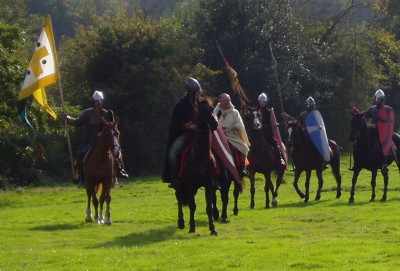
Norman knights led by Bishop Odo of Bayeux riding into battle under the papal banner. Image taken at English Heritage's annual Battle of Hastings re-enactment.
One of the most common questions that readers of Sworn Sword ask me is why I chose to write from the Norman perspective, rather than that of the English, as might be expected. In fact this was a decision that I made very early on in the novel’s development, when it was little more than a bundle of research notes and half-formed plot ideas.
I had long been fascinated by the Conquest, and I knew that what I wanted to write about were the years that followed the Battle of Hastings: a turbulent period as the Normans fought to consolidate their gains and subdue a country rife with rebellion. (The story of one of those rebellions, led by the dispossessed prince Eadgar, forms the backbone of the novel.) However, while the theme of the tragic-heroic struggle of the Anglo-Saxons against their foreign oppressors seemed to me very familiar, the Norman version of events was not generally as well known. Straightaway, then, I started to think about giving the tale of the Conquest a fresh twist, by telling it from the “other” point of view.
Every story has two sides. One man’s freedom fighter is another man’s insurgent. These sayings are so familiar as to have almost become clichés. By blurring the traditional distinction between the “good” English and the “evil” Normans, I hoped to show the period in a different light, to challenge readers’ sympathies and preconceptions. So far as I could see it was an angle that few authors had taken before, which made this a subject ripe for exploration.
Even so, to get the modern reader on the side of the foreigner is no easy task. Why this should be isn’t completely clear. After all, it goes almost without saying that the Englisc of the eleventh century are not at all the same people as the English of the twenty-first. Moreover, were it not for the Normans, we would not speak the language we do today, our systems of law and governance would be entirely different, as so too would our cultural heritage, since all are based on the foundations that they laid. The world we live in today owes as much, if not more to the Normans than it does to the Anglo-Saxons.
None of that, of course, is to deny that the Norman invasion was a brutal affair, or that it resulted in tremendous suffering for many thousands of people. In particular the campaign later known as the Harrying of the North, by which King William devastated Yorkshire in the winter of 1069-70, is testament to that. Nonetheless, to suggest that the Normans were universally bad men would be a gross oversimplification. Undoubtedly some came to England purely for self-serving reasons – out of desire for land and wealth, blood and glory – but I believe that many were also complex human beings who truly believed in the righteousness of their cause.
William of Normandy’s case for war in 1066 was built on two main pillars. The first of those was that the claim that he had been promised the succession by King Edward the Confessor in 1051. The second was that in c. 1064 Harold Godwineson had sworn on holy relics to uphold his right to the throne: a promise that he had subsequently broken when he himself seized the crown upon Edward’s death in January 1066. As far as the invaders were concerned, then, Harold was a perjurer and a usurper who had no right to the English crown. Worse than that, he was effectively made an enemy of God after Pope Alexander II gave his approval to William’s proposed invasion and sent him a consecrated banner under which to fight. To a Christian knight riding in the Conqueror’s army, there would have been little question that he was on the side of justice. William was the rightful king, anointed by God, and any who rose against him were to be crushed.
However, as Tancred finds out over the course of Sworn Sword, it is often difficult to tell who is right and who is wrong in any given situation. There are times when men will betray their principles in noble causes; on other occasions they will hold steadfastly to them even if it means the destruction of all that they hold dear. Englishmen will fight in the service of Normans and vice versa, to the extent that the “sides” become blurred and it becomes harder to talk about this period as a simple conflict between the two peoples, still less as one of good versus evil.
In reality the Conquest was a complicated and morally messy affair, and by offering a different perspective this is what I hope to show in Sworn Sword.
First copies of the large print edition of Sworn Sword arrived recently and look fantastic. Published by AudioGO, one of the best-established large print publishers in the UK, it won’t be released commercially but instead will be available mainly in libraries and hospitals, as well as from hard-of-sight charities.
Apart from a few cosmetic changes to the front cover design and a snappier blurb on the back, the overall look is not unlike that of the original hardback. It’s inside that the real differences become apparent, as the photos below show.
There’s news too of the German mass market paperback edition, published by Goldmann, which is due to hit the bookshelves in August 2012. The title, I’ve been told, will be Der Pakt der Schwerter, which translates literally as The Pact of Swords.
I can’t wait to see the finished product, and I’ll post pictures here on the blog as soon as I receive advance copies next year. Eventually I hope to post a picture of all the different editions of the book – hardcover, paperback, foreign and large print – lined up next to one another: a kind of Sworn Sword family photo!
After visits to Cambridge, Salisbury and Bath in recent weeks, the Sworn Sword tour stopped off last week in Wantage, Oxfordshire, for the very first Betjeman Festival. I was in conversation with Stephanie Merritt, better known as S.J. Parris, author of the excellent Elizabethan mysteries Heresy and Prophecy, about the attractions and challenges of historical fiction as a genre.
It’s always fascinating to discover the similarities and differences between other historical novelists’ approaches and my own, particularly when it comes to the all-important question of fact versus fiction. How much licence does a writer take when it comes to historical fact? Is it acceptable to alter the course of events in order to make for a better story? Or does the truth always take precedence, and must the fictional narrative be woven around that framework?
It was pointed out that whereas for Sworn Sword I have taken as my protagonist a fictional Norman knight, Stephanie’s novels feature the real-life character Giordano Bruno, a renegade monk and philosopher hailing from sixteenth-century Italy. While on the surface those might seem like two very different approaches to writing novels set in the past, when it comes to deciding how much licence to take with historical events, our views turned out to be very much alike. Whenever the drama of the story comes up against the facts, we both agreed, it is the story that has to win out. But when it comes to the small details that flesh out a setting and contribute to the period atmosphere – the food and drink or the décor of the time, for example – it’s important to get as much right as possible.
Of course the advantage in writing a novel set during the medieval period, at least compared with later centuries, is that the sources are sparser, the gaps in our knowledge wider and the uncertainties more pronounced. For the novelist, then, there are more opportunities to invent where things are not definitively known. Even so, getting the right balance between authenticity and a well-paced narrative is a tricky business. It’s a subject that I’m sure I’ll be returning to on this blog in future, as well as discussing during my upcoming events.
Speaking of which, coming up on Thursday 29 September is the first-ever History in the Court at Goldsboro Books in Cecil Court near Leicester Square in London. I’ll be there signing books and talking to readers about my work, along with as many as fifty other historical novelists including such luminaries of the genre as Bernard Cornwell and C.J. Sansom, both of whom were significant influences on my writing, as well as Ben Kane, Robyn Young, Simon Scarrow and many more besides.
Building on the success of the popular annual Crime in the Court event, it looks set to be a great evening and a unique chance to meet lots of your favourite historical authors in person. The event begins at 5pm and will carry on until 9pm. Tickets are £5 and can be purchased online
For details of all my upcoming engagements, visit my Events page. I’m adding new signings and talks all the time, especially in the run-up to Christmas. Already I’m starting to fill out my calendar for 2012 too, so keep checking back to find out when I’ll be visiting your area.


